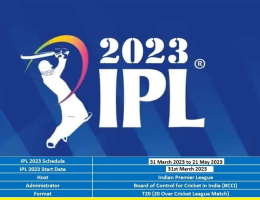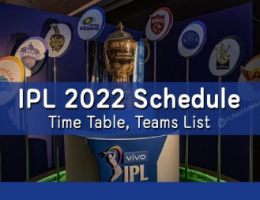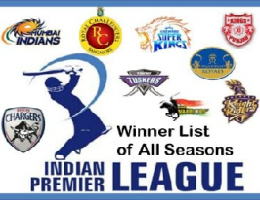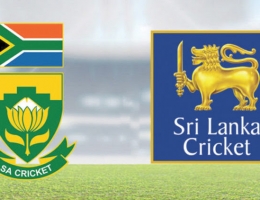
Indian Premier League (IPL)
Indian Premier League (IPL)
- By --
- Sunday, 16 Jan, 2022
Indian Premier League
The Indian Premier League (IPL), an Indian professional Twenty20 (T20) cricket league established in 2008. The league, which is based on a round-robin group and knockout format, has teams in major Indian cities.
The brainchild of the Board of Control for Cricket in India (BCCI), IPL has become one of the most lucrative and most popular outlets for the game of cricket. Matches usually begin in the late afternoon or evening so that at least a portion of them are played under floodlights at night in order to maximize television viewership for worldwide broadcast. Initially, league matches were played between all teams on a home-and-away basis, but, with the planned expansion to 10 clubs in 2011, some teams were allowed to play between teams. Was. For this the format was changed. The matches were limited. for a single meeting. The top four teams contest three play-off matches, with the losing team being given a second chance to advance to the final, a win-win with the aim of maximizing potential television revenue. The play-off portion of the tournament consists of four teams that finish at the top of the table in a series of knockout games that give a team a second chance to advance their first round of play to the final match.
With the advent of the IPL, almost overnight the best cricketers in the world - who rarely made money in other professional sports - became millionaires. IPL franchise owners, which include major companies, Bollywood movie stars and media moguls, bid for the best players in an auction organized by the league. At the start of the IPL, the well-financed Mumbai Indians had the league's biggest payroll, over $100 million. Indian national team opener Gautam Gambhir was signed by Chennai Super Kings for $1.5 million in 2011 and Kolkata Knight Riders for $2.4 million in the opening auction of the 2008 season to secure the services of Mahendra Dhoni. weather.
The eight founding franchises were Mumbai Indians, Chennai Super Kings, Royal Challengers Bangalore, Deccan Chargers (based in Hyderabad), Delhi Daredevils, Punjab XI Kings (Mohali), Kolkata Knight Riders and Rajasthan Royals. Jaipur). In late 2010, two franchises, Rajasthan and Punjab, were expelled from the league by the BCCI for breach of ownership policy, but were later reinstated in time for the 2011 tournament. Two new franchises, Pune Warriors India and Kochi Tuskers Kerala, joined the IPL for the 2011 tournament. The Kochi club played just a year before the BCCI terminated its contract. In 2013, Deccan Chargers was replaced in IPL by Sunrisers Hyderabad.
The first tournament, held in 44 days in 2008, was won by Rajasthan Royals, one of the smaller market franchises, captained by the legendary Australian bowler Shane Warne. In the wake of the success of the IPL, other cricketing nations scrambled to grab some money by creating their own domestic T20 leagues.
Twenty20 cricket
Twenty20 cricket, also known as T20, is a shortened form of cricket that revolutionized the game when it was introduced in 2003 with a change in the rules, bringing a new audience to cricket . Hitting and scoring carried a premium. Keep this.
Rules and History
The basic rules for the longer versions are the same, but the innings is limited to 20 overs (an over consisting of six balls, or an over bowled by a bowler to the batsman on the opposite wicket), for a maximum of four overs each. Restrictions on the appointment of fielders by bowlers and batsmen designed to encourage big hitting and high scores. In no time, T20 has become the most popular and lucrative form of cricket, especially in India, where Indian Premier League (IPL) matches draw huge crowds and are watched by millions on television. A shortened form of cricket known as Cricket Max was developed in New Zealand in the 1990s by former Test batsman Martin Crowe, but the official rules for T20 were established by the England and Wales Cricket Board, and the first tournament was played by the English. County teams in 2003.
The format was quickly adopted by other countries, and two years later Australia and New Zealand played the first official international T20 match in a light-hearted T20 match in Auckland. Both sides wore 1980s uniforms and (mostly fake) mustaches. However, it quickly became clear that T20 had the potential to attract new, vibrant, young audiences to cricket. The first T20 World Cup, which was played in South Africa in 2007, was won by India, creating a huge market for T20 on the subcontinent, which was increasingly tapped by the IPL. Subsequent World Cups were played in various cricket playing nations, with West Indies holding the most titles (two). Each major cricket country developed its own domestic T20 tournament and a Champions League competition between the best club sides.
Professionalism
Professionalism, the standards, practices, or motivations associated with a profession. The concepts of professionalism, profession, and professionalization have received considerable and sometimes critical attention in sociology. In early British and American analyses, professionalism was identified as an occupational value that was important for the stability and civility of social systems. In those interpretations, professional relations were characterized as collegial, cooperative, and mutually supportive. Relations of trust characterized practitioner-client and practitioner-management interactions, as competence was assumed to be guaranteed by education, by training, and sometimes by licensing.
However, a second, more cynical interpretation of professionalism grew out of the more critical literature on professions that was prominent in Anglo-American analyses in the 1970s and ’80s. During that period, professionalism came to be dismissed as a successful ideology and professionalization as a process of dominance over an occupation or a market. Professionalization, according to that interpretation, was intended to promote professionals’ own occupational self-interest with respect to salary, status, and power, as well as monopoly protection of an occupational jurisdiction. Professionalization was a process largely initiated and controlled by the practitioners themselves through their professional institutions and associations in order to promote and protect their own interests.
A third and later development involved the analysis of professionalism as a discourse of occupational change and control, especially in work organizations in which such discourse was increasingly applied and utilized by managers. There is an important difference between the discourse of professionalism as constructed “from within” (by the occupational group itself) and as constructed “from above” (by managers in work organizations). When the discourse is constructed from within, the benefits to the group can be substantial. The occupational group uses the discourse to construct its occupational identity, promoting its image with clients and customers, and in bargaining with states to secure and promote the occupational control of work by practitioners. In contrast, when the discourse is constructed from above, it is usually false or selective and used to facilitate occupational change and rationalization. The effects are not the occupational control of work by the practitioners but rather control by the organizational managers and supervisors. Organizational objectives define practitioner-client relations and set achievement targets and performance indicators. Organizational objectives regulate and replace occupational control of practitioner-client work interactions, thereby limiting the exercise of discretion and undermining the service ethic that has been important in professional work.
Professionalism as an occupational value can be threatened by the imperatives of efficiency and effectiveness emphasized by the managerial control of work. The American sociologist Talcott Parsons argued that the professions, by means of their collegial organization and shared identity, demonstrated an alternative to the managerial hierarchy of organizations. Studies conducted in the early 21st century demonstrated that professionalism presents advantages for both clients and practitioners over other ways of organizing work in contemporary societies (such as managerial or market-based organization). Those studies highlighted the importance of maintaining professionalism—along with trust, competence, and discretion—as the main organizing principles for service work in modern societies.
IPL Cricket Id
cricket, England’s national summer sport, which is now played throughout the world, particularly in Australia, India, Pakistan, the West Indies, and the British Isles.
Cricket is played with a bat and ball and involves two competing sides (teams) of 11 players. The field is oval with a rectangular area in the middle, known as the pitch, that is 22 yards (20.12 metres) by 10 feet (3.04 metres) wide. Two sets of three sticks, called wickets, are set in the ground at each end of the pitch. Across the top of each wicket lie horizontal pieces called bails. The sides take turns at batting and bowling (pitching); each turn is called an “innings” (always plural). Sides have one or two innings each, depending on the prearranged duration of the match, the object being to score the most runs. The bowlers, delivering the ball with a straight arm, try to break (hit) the wicket with the ball so that the bails fall. This is one of several ways that the batsman is dismissed, or put out. A bowler delivers six balls at one wicket (thus completing an “over”), then a different player from his side bowls six balls to the opposite wicket. The batting side defends its wicket.
Two batsmen are up at a time, and the batsman (the striker) tries to hit the ball away from the wicket. A hit can be defensive or offensive. A defensive hit can protect the wicket but the batsmen do not have time to run to the opposite wicket. In that case the batsmen need not run, and the game will resume with the second bowl. If the batsman can hit the offensive, he and the other batsman (nonstriker) switch places on the second wicket. Whenever both the batsmen can reach the opposite wicket, a run is scored. Provided they have enough time without getting caught and dismissed, batsmen can continue to cross back and forth between wickets, earning extra runs each time the two reach in opposite directions. There is an outer boundary around the cricket field. A ball goes over or outside the boundary if it hits the ground and then reaches the boundary, six points if it reaches the boundary (a fly ball) from the air. The team with the most runs wins a match. If both teams are unable to complete their number of innings before the stipulated time, the match is declared a draw. Scoring a century is common in cricket.
Matches in cricket can range from informal weekend afternoon matches to five-day Test matches at village grounds, to top-level international competitions and grand stadiums played by prominent professional players.
History
Cricket is believed to have originated in the 13th century as a game in which boys bowled on tree stumps or in a sheep's shed at a hurdle gate. This gate had two uprights and a crossbar at the slotted top; The crossbar was called a bell and the entire gate was called a wicket. The fact that the bail could be removed when the wicket was struck made it preferable to the stumps, which were then fitted over the barrier. Early manuscripts differ regarding the size of the wicket, which achieved the third stump in the 1770s, but by 1706 the pitch - the area between the wickets - was 22 yards long.
The ball, which was once probably a stone, has remained almost the same since the 17th century. Its modern weight was established in 1774 to be between 5.5 and 5.75 oz (156 and 163 g).
The primitive bat was undoubtedly a tree-shaped branch, similar to a modern hockey stick, but much longer and heavier. The straight bat was modified to avoid length bowling, which developed with the cricketers in Hambledon, a small village in South England. The bat was shortened in the handle and straightened and widened in the blade, allowing further play, driving and chopping. As bowling techniques were not very advanced during this period, batting dominated during the 18th century.
The earliest reference to an 11-a-side match played for a 50 Guinness stake in Sussex is from 1697. Kent met at the first recorded intercount match at Dartford from Surrey in 1709, and it is possible that a code of laws (rules) existed for the conduct of the game at this time, although such rules were the earliest known. The version dates back to 1744. Sources state that cricket was confined to the southern counties of England in the early 18th century, but its popularity grew and eventually spread to London. , especially the Artillery Ground, Finsbury, which included a link between Kent and All-England in 1744. The famous match was watched. Heavy bets and chaotic crowds were common in matches.
The aforementioned Hambledon Club was the dominant cricket force, playing in Hampshire at penny Down in the late 18th century before the rise of the Marylebone Cricket Club (MCC) in London. Formed from a cricket club that played at White Conduit Fields, the club moved to Lord's Cricket Ground in the borough of St Marylebone in 1787 and became the MCC and published its first revised code of laws the following year. Lord's, which was named after its founder Thomas Lord, has three places in history. Lord's became the headquarters of world cricket after it was moved to the present ground at St John's Wood in 1814.
The first match of North Counties vs South Counties was played in 1836, giving clear evidence of the spread of cricket. The All-England XI, founded by William Clark of Nottingham in 1846, began to tour the country, and from 1852, when some of the leading professionals (including John Wisden, who later compiled the famous Wisden Almanacs on Cricket) parted ways. Forming the United All-England XI, these two teams monopolized the best of cricketing talent until the rise of county cricket. He supplied players for the first English touring team abroad in 1859.
Technological Advances
All bowling was secret until the early 19th century, and most bowlers favored the high-toss lob. Then came the "round-arm revolution", in which many bowlers began to raise the point at which they released the ball. Controversy erupted furiously, and in 1835 the MCC redefined the law to allow the arm to be raised to the shoulder. The new style greatly increased the speed, or tempo, of bowling. Slowly the bowlers raised their hands up and over, flouting the law. The matter came to light in 1862 when an England team playing against Surrey protested a "no ball" call (i.e., an umpire's decision that the bowler had bowled an illegal pitch) at the Kennington Oval in London. left the field. The argument centered on whether the bowler should be allowed to raise the arm above the shoulder. As a result of this dispute, the bowler was officially given the freedom to overhand (but not cock and straighten the arm) in 1864. This change dramatically changed the game, making it even more difficult for a batsman to judge the ball. Already a bowler was allowed to run from any direction and to any distance. Once the bowler was allowed to release the overhand, the ball could reach speeds above 90 mph (145 km/h). Although it is not as fast as the pitching speed in baseball, cricket has an additional twist in that the ball is usually bounced onto the pitch (field) before it hits the batsman. Thus, the ball may swing to the right or left, bounce low or high, or spin towards or away from the batsman.
Batsmen learned to protect themselves with pads and batting gloves, and the handle of the cane increased the flexibility of the bat. However, only the best batsmen could tackle the fast bowling, as the poor condition of most pitches made it even more difficult for the batsman to estimate the speed of the ball. However, as the field improved, the batsmen got used to the new bowling style and became aggressive. Other new bowling styles were also discovered, allowing batsmen to further adjust their technique.
In the early 20th century, so many runs were being scored that there was debate over the reform of the "leg-before-wicket" law, which was defined in the 1774 laws to allow a batsman to use his body to prevent the ball from being hit. could use. His wicket. Started to stop, but the heavy scores were actually due to the performances of several outstanding batsmen, such as WG Grace, Sir John Berry Hobbs and K.S. Ranjitsinhji (later Maharaja of Nawanagar). This was the golden age of cricket.
Several attempts were made in the 20th century to assist the bowler and speed up the pace of the game. Nevertheless, until the middle of the 20th century the game was characterized not by heavy offense but by defensive play and the slow pace of both sides. Cricket was introduced in an attempt to shore up a dwindling fan base, one-day or limited-overs. One-day cricket was first played at international level when it rained on the first day after a Test match, on the last schedule.
Organization of the game and types of competition
Some of the earliest cricket matches held were between amateur and professional players. From 1806 (annually since 1819) to 1962, the gentleman-versus-players match pitted the best amateurs against the best pros. The series ended in 1962 when the MCC and the counties left the distinction between amateurs and professionals. Other early cricket matches took place between British universities. The Oxford-vs-Cambridge match, for example, has been played mainly at Lord's since 1827 and became a high point of the summer season in London.
University cricket was a kind of nursery for county cricket – that is, matches between different counties of England. Although the press praised the "Champion County" (Sussex) as early as 1827, the qualification rules for county cricket were not set until 1873, and it was only in 1890 that the format of the county championship was formalized by the counties. , Gloucestershire dominated in the 1870s, thanks to WG Grace and his brother E.M. and G.F. Courtesy. From the 1880s until World War I, Nottinghamshire, Surrey, Yorkshire, Lancashire, Kent and Middlesex formed the Big Six that dominated county cricket. The northern counties, largely professional teams, were the leaders after the First World War, led by Yorkshire and Lancashire. Surrey, with seven consecutive championships, dominated the 1950s and Yorkshire into the 1960s, followed by Kent and Middlesex in the 1970s. Middlesex, Worcestershire, Essex and Nottinghamshire dominated the 1980s. Other counties in first-class county cricket are Leicestershire, Somerset, Hampshire, Durham, Derbyshire, Warwickshire, Sussex, Northamptonshire and Glamorgan.
After the post-war boom, slow play and low number of runs were characteristic of the 1950s, and this defensive nature of county cricket led to a progressive decrease in attendance. In the 1960s the MCC and counties introduced one-day knockout competitions – called the Gillette Cup (1963–1980), the NatWest Bank Trophy (1981–2000), the C&G Trophy (2000–06), and the Friends Provident Trophy . (2006–09) – and a separate Sunday Afternoon league (both competitions merged to form the Clydesdale Bank 40 in 2010), which revived public interest, although most counties received income from football pools and funds from Test matches. Has received. Financially dependent and broadcast fees. Immediate registration of foreign players was allowed, and each county, in the early 1980s, allowed a player who could still play for their national team. The change worked well for the counties, and it also strengthened the national teams those players appeared for. In county cricket, bonus points were scored to encourage batsmen and bowlers to play less defensively, and from 1988, four-day games replaced the three-day format, allowing young batsmen and spin bowlers to develop. helped. changed rapidly. The longer game gives the batsmen more time to score an innings and relieves them of the pressure of scoring runs quickly. Spin bowlers benefit from longer games because as the game progresses the pitch gets worse and more spin is allowed.
Cricket Council and ECB
English cricket was reorganized in 1969, resulting in the end of the MCC's long reign as the sport's governing body, although the organization still retains responsibility for the laws. With the establishment of the Sports Council (a government agency responsible for the control of the sport in Great Britain) and the possibility of obtaining government support for cricket, the MCC was asked to create a governing body for the sport that was generally accepted. was done. other. Sports in Great Britain. The Cricket Council, which included the Test and County Cricket Board (TCCB), the National Cricket Association (NCA) and the MCC, was the result of these efforts. The TCCB, which amalgamated the Advisory County Cricket Committee and the Board of Control for Test Matches at Home, had responsibility for all first-class and minor county cricket in England and overseas tours. The NCA consisted of clubs, schools, armed services cricket, umpires and representatives of the Women's Cricket Association. A further reorganization took place in 1997, and the TCCB, the NCA and the Cricket Council were all subordinated to the England and Wales Cricket Board (ECB).
International Cricket
International cricket in the early 20th century was dominated by the original members of the Imperial Cricket Conference, England, Australia and South Africa. Later renamed the International Cricket Conference and then the International Cricket Council, the ICC gradually assumed greater responsibility for the administration of the game and shifted its power base from west to east. When in 2005 the ICC moved its offices from Lord's in London - home of the MCC, the game's original ruler and still its law
Australia
One of the founding members of the ICC, Australia is one of its most powerful nations both on and off the field. The history of cricket in Australia dates back to 1803, when the game was introduced by the crew of a British ship. The first intercolonial match took place in 1851 between Victoria and Tasmania, and by the end of the 19th century England teams were regularly touring Australia. The first official Test match was played by Australia and England in Melbourne in 1877, marking the beginning of the oldest rivalry in international cricket, known as The Ashes (see Test match below).
Cricket is played throughout Australia, and matches are fiercely competitive at every level. From Sir Don Bradman to Shane Warne, all great Australian players developed their skills in club cricket before graduating to state and national teams, and practiced Australian-style cricket with bat, ball and, often, voice in an effort. was done with. were played together. marked by aggression. intimidating opponents. During the 20th century, Australia produced a series of outstanding teams, and the country dominated international cricket in the new century, winning three consecutive One Day World Cups (1999–2007) and 16 consecutive Test victories (1999–2001). Won. Won. ) was entered twice. and 2005-08). England's Test victory over Australia in 2005, for the first time since 1987, was celebrated with an open-top bus ride through the City of London.
Bangladesh
In June 2000, Bangladesh became the 10th country to achieve full testing status. It played its first Test match against India in Dhaka in November of the same year. The Bangladeshi team, known as the Tigers, struggled to perform at the highest level, winning only three of their first 68 Tests. However, Bangladesh have defeated nine nations that preceded Test status in ODIs, a feat which was achieved with a win over England in Bristol in 2010. Bangladesh's first appearance in an international tournament came in England in ICC Trophy competition. Associate member in 1979. Bangladesh won the trophy in 1997 and qualified for the 1999 World Cup, defeating Pakistan in the group stages. A domestic first-class tournament between six regional teams was established in 2000–01. Ever since Bangladesh achieved Test status, cricket has become arguably the most popular sport in the country.
India
Cricket is played in every corner of India, on city streets, in village grounds and in fields – open playgrounds, the largest of which (such as the Azad, Cross and Oval grounds in south Mumbai) host dozens of overlapping matches. Is. Is. What can we do? Historically, Indian cricketers have displayed a good eye and strong wrists, and Indian batsmen, especially Sunil Gavaskar and Sachin Tendulkar, have been some of the most productive and stylish in the history of cricket. The dry flat pitches of the subcontinent have also traditionally produced high-class spin bowlers.
The game started in India in the 18th century. A touring team led by the English gentleman cricketer Lord Hawke played a match against the "All India" team in January 1893. India played its first Test in 1932 and waited 20 years for their first Test victory against England at Madras (now Chennai). However, the game developed so rapidly in India that by the end of the 20th century, India was one of the leading cricket nations in the world. With the development of the Indian Premier League in the early 21st century, it became the undisputed home of Twenty20 cricket and the financial center of the international game, although the popularity of Test cricket in India has declined dramatically. India's prominence in one-day cricket was confirmed when it won the Cricket World Cup in 2011.
New Zealand
Cricket has always been second only to rugby in the sporting preferences of New Zealand players, but like Australia, the sport has a strong national structure. The country's long history of domestic cricket often dates back to the first representative inter-provincial match between Auckland and Wellington in 1860, although there is evidence that informal matches between provinces were played in New Zealand decades earlier. The NZ Cricket Council was formed in 1894 and incorporated into full membership of the ICC in 1926. With only a small base of players on which to draw, New Zealand has always struggled to compete with England and Australia in Test cricket. Like most cricketing nations, the one-day game has proven to be more popular in New Zealand. Knighted in 1990, Richard Hadlee went on to produce one of the greatest cricketers of any era in the country.
Pakistan
The development of cricket in Pakistan has been almost equal amounts of chaotic, quirky and fascinating. Under Imran Khan's leadership, Pakistan won the 1992 World Cup, but its cricket was often marred by political interference and scandal. In 2010 a low point was reached: to begin with, the national team was in virtual exile, unable to persuade other countries.
West Indies
Cricket has been a unifying force in the Caribbean since the West Indies became the fourth Test playing side in 1928. The islands have generally played other sports as independent countries, but British colonial influence contributed to the formation of a joint regional team. In the 1970s and 80s, when the West Indies team displayed a quartet of fast bowlers led by Michael Holding, Malcolm Marshall, Andy Roberts and Joel Garner, and the destructive ability of Sir Viv Richards and Clive Lloyd. West Indies were virtually unbeatable. Blessed with an abundance of talented players and genuine pitches, Caribbean cricket has always been played with an unconventional flourish, most clearly seen in the batting of Sir Garfield Sobers, Richards and Brian Lara.
The lack of strong administrative leadership and the growing appeal of potentially more lucrative sports such as athletics (track and field), football (soccer) and basketball resulted in a decline in the popularity of cricket in the West Indies in the 21st century. After playing in the finals of the first three World Cups (1975, 1979, and 1983) and winning the first two, the West Indies team failed to reach the knockout stage of subsequent World Cups, with the exception of 1996. hosting the event.
Zimbabwe | Online Cricket Id
The country's best cricketers like Colin Bland played for South Africa until Zimbabwe was given Test status in 1992. In fact, the history of cricket in both the countries is inextricably linked. Teams representing their Rhodesian predecessor states participated in the Currie Cup, a South African domestic first-class tournament (first in 1904–05, then early) long before the newly independent and in 1980 Zimbabwe was named an affiliate of the ICC. went. became a member.. Competing in its first World Cup in 1983, Zimbabwe stunned the world by defeating Australia, yet Graeme Hick, arguably the best batsman in the country, left shortly after to play for England.
Zimbabwean cricket in the early 21st century has been marked by chaotic administration and political interference. After Heath Streak was sacked as captain of the national team in 2004, it took several years for Zimbabwe to emerge, which included relegation from Test cricket starting in 2006 and 2011. The political instability of the country during this period had a lot to do with it.
Read More - http://thetiis.com/Online-Betting-ID
Facebook – https://www.facebook.com/Online-Betting-Id-TIIS-104841985403800/
Instagram - https://www.instagram.com/thetiisbettingtips/
Youtube - https://www.youtube.com/channel/UCFimmDDB8iBNXpUUFRIuEIA
for more information please fill the form
*Alert - This game involves element of financial risk and may be addictive. Please play Responsibly at your own risk. This is only for educational purposes. This Website is totally for those people where betting is legal... We are just provide tips on our personal knowledge and experience. We're working within the guidelines.








